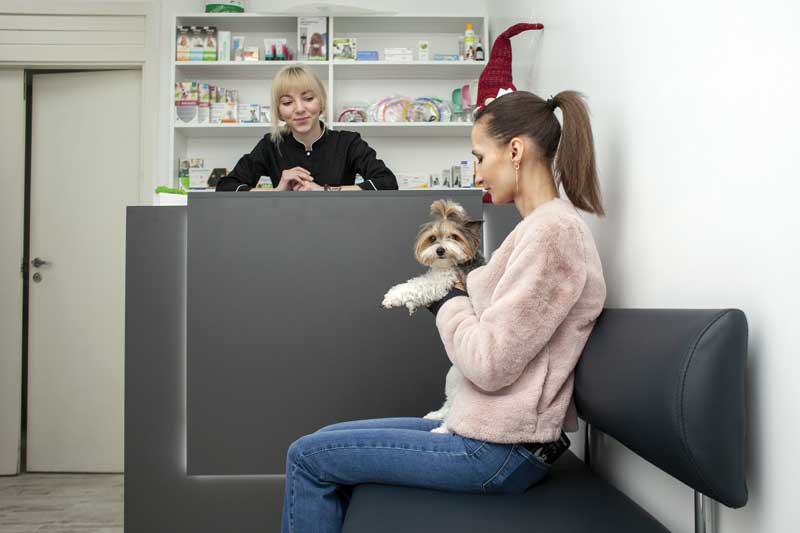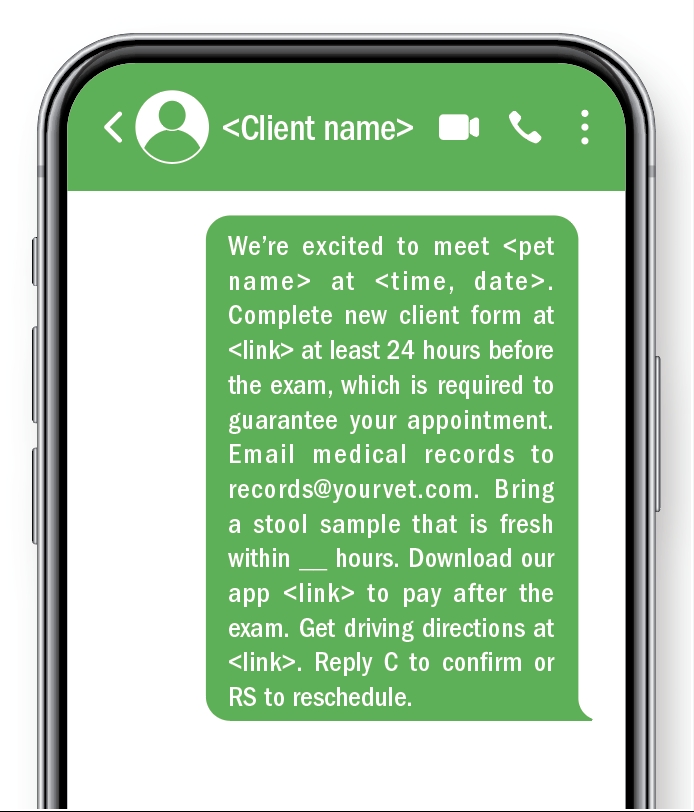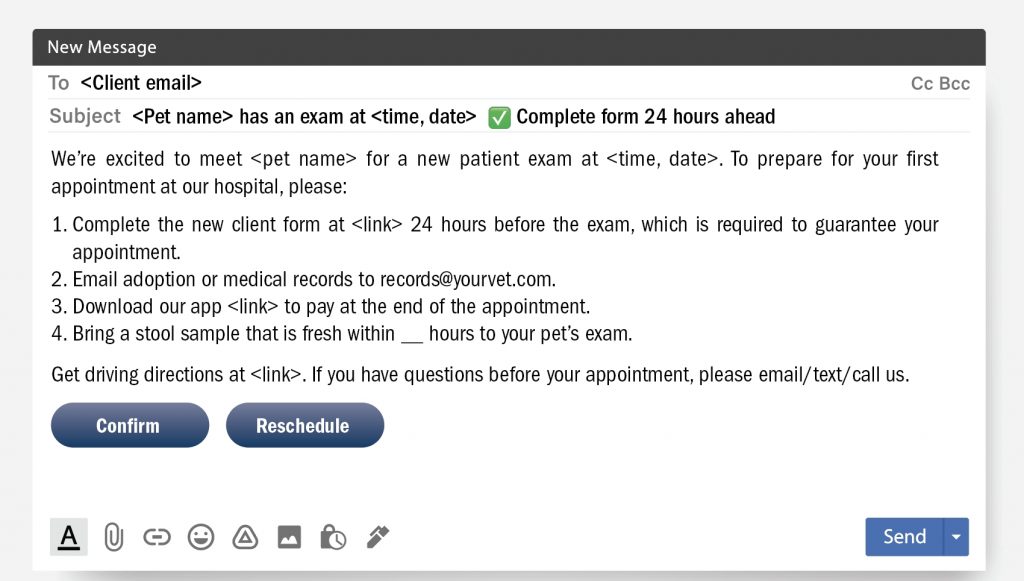My husband and I recently moved to Florida and searched for a new veterinarian for our two cats that are due for checkups next month. I used the American Animal Hospital Association (AAHA) hospital locator to find University Animal Clinic in University Park, Fla., and booked an appointment. Client service representative, Suzanne, was friendly, scheduled the appointment, got my contact information, and explained how to email records. She said I would receive an email confirmation with additional instructions. Setting expectations during the scheduling call and following up with email or text will engage new clients and cement relationships.
New clients help you maintain and grow your practice. Create a standard operating procedure (SOP) on how to welcome new clients, so your teammates know their roles. Here are best practices and lessons from our recent experience of becoming new clients:
Sending immediate confirmation
After I hung up, I got an email confirming the appointment and added it to my calendar, turning on travel time alerts. Clients should get a series of four confirmations when booking:
1) Immediate
2) Two weeks prior
3) Four days prior
4) Two days prior
The series helps clients arrive on time, send records in advance, and prevent no-shows.
For text confirmation:
For email confirmation:
Given 62 percent of emails are opened on mobile devices, you need short and captivating subject lines.1 Keep it within 30-40 characters to fit it on a mobile device interface. You can also integrate emojis within your subject line to save space and increase open rates by 56 percent.2
Getting medical records ahead
This is a huge timesaver. Create a specific email folder where records are received so they do not get buried in your clinic’s general inbox. Having records before appointments lets doctors and technicians review patients’ history and anticipate which medical services may be needed beyond vaccines.
For example, our 12-year-old cat, Caymus, has cardiomyopathy. Knowing this in advance may prompt the veterinarian to discuss senior blood work, urinalysis, and cardiac workup for monitoring of the chronic condition.
Asking for online forms
Avoid handing new clients a clipboard with your form upon arrival. Paperwork will cut into valuable exam time. Clients will take 20 minutes to complete most pen-and-paper forms compared to less than 10 minutes for online forms.3
Create online forms based on the reason for the visit. Use different forms for checkups, illnesses, progress exams, technician appointments, day admissions, and new puppy/kitten exams.
When you set up appointment type templates in your practice-management software, link the corresponding confirmation message. For example, a client with a checkup will receive a confirmation with a link to a preventive history form. A client with a sick patient appointment will receive a medical concern form with questions such as: “What symptoms has your pet been experiencing?” “When did the problem start?” and “Have the symptoms worsened, improved, or stayed the same since you first noticed them?”
Ask your website provider to design your online forms or use website form makers. Clients will click a “submit” button after filling out the form, and data will be sent to a specific email address at your hospital such as records@yourvet.com. This allows you to quickly locate completed forms and add data to electronic medical records.
Online history forms also improve productivity. Instead of 10 minutes to ask about diet, use of preventatives, sneezing, coughing, and other standard questions, a technician can review answers on the online form and just ask follow-up questions. The doctor can begin the exam sooner thanks to the shortened history collection process.
Use the app
I received a follow-up email from University Animal Clinic to download its mobile app where I could book appointments, request refills, get reminders, and pay.
Switching clients from email to app communication preferences will increase client engagement and responses. Texts and app messages have a 98 percent open rate and 45 percent response rate.4 Research shows 90 percent of clients will respond to texts within 30 minutes.5
Greeting by name
Client service representatives should check the schedule throughout the day and know the names of the next three arrivals to have personal greetings. Say, “Welcome to our hospital, Wendy. It’s great to meet you, Alex, and Caymus. Thanks for completing your online forms and emailing records. I will let the doctor and technician know that you’ve arrived. What questions may I answer before we get started?”
Providing welcome gifts
Have canvas bags imprinted with your logo, phone number, and website. To determine how many bags to order, look at last year’s new client numbers in your software. Ask pharmaceutical and pet food sales representatives about brochures and items they could contribute.
Add literature based on the pet’s life stage. For example, new clients with senior pets would receive brochures on early detection screens, arthritis, and senior nutrition. A new client with a puppy would receive house-training and socialization handouts and a free dose of heartworm and flea/tick preventatives. Stuff new client gift bags with:
- Slip leash with your clinic name and phone number
- Your business card
- Emergency clinic info and/or magnet
- Pet food measuring cup and can lid cover
- Vaccine record keeper
- Dental report card
- Pen with your logo, phone number, and website
- Toy or treats
- Puppy/kitten gift
- Gift certificate to try boarding or grooming services
Have the hospital manager welcome new clients
Each morning, the manager should check the schedule and look for new client exams. During each appointment, the manager should step into the exam room, greet the new client, and provide a business card. Say, “Welcome to our hospital. My name is <name>, and I’m the hospital manager. We strive to provide exceptional patient care and client service, so please contact me if you have questions. Here’s my card.”
Forward booking the next appointment
You want to cement new client relationships to begin a lifetime of care. Encourage booking the succeeding appointment during checkout. Say, “Let’s schedule your puppy’s next exam. The doctor can see your puppy on <date, time 1> or <date, time 2>. Which do you prefer?” Forward booking ensures timely care and guarantees future revenue.
Write an SOP of each step of the new client experience. Create email and text templates, scripts, online forms, and communication that will ensure welcoming and consistent messages from your team.
Wendy S. Myers, CVJ, has taught communication and client service skills for more than two decades. As founder of Communication Solutions for Veterinarians, Myers teaches practical skills through online courses, onsite coaching, and conferences. She was a partner in a specialty and emergency practice. Visit YouTube.com/csvets and Csvets.com for more.
References
- Infographic: The Ultimate Mobile Email Open Statistics. EasySendy. Available at: https://easysendy.com/blog/mobile-email-open-statistics. Accessed April 18, 2023.
- The Real Scoop on Email Emoji in Subject Lines. Campaign Monitor. Available at: https://www.campaignmonitor.com/blog/email-marketing/the-real-scoop-on-email-emoji-in-subject-lines. Accessed April 18, 2023.
- 6 myths about online patient forms debunked. PatientStudio. Available at: https://patientstudio.com/6-myths-about-online-patient-forms-debunked. Accessed Dec. 14, 2021.
- Cote S. The Future of Sales Follow-Ups: Text Messages. Gartner. Available at: https://www.gartner.com/en/digital-markets/insights/the-future-of-sales-follow-ups-text-messages. Accessed April 18, 2023.
- Meyer B. 29 Best Text Message Templates to Increase Sales in 2023. Omnisend.com. Available at: https://www.omnisend.com/blog/text-message-templates. Accessed April 18, 2023.



